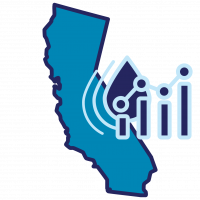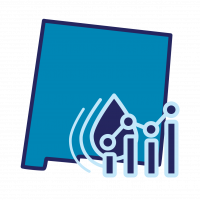State Action on Open Water Data
What’s the Issue?
Water data are collected by a variety of governmental agencies, at the local, state, and federal levels, and non-governmental organizations. These data are published on a variety of platforms. For example, one study counted at least fifteen separate sites that record and provide water data in Texas. These platforms, unless directed by legislation, present data in different formats and varying standards. The current water data landscape is fragmented and proves difficult for stakeholders to navigate.
This proves a challenge for water management. Water data is required to make informed decisions and evidence-based policies that regulate water in and across states. Available and accessible water data can “enhance sustainability, improve management, and inform decision-making” across the local and state level. Policies that promote the consolidation of water data in a common and open platform ensure easier access of data. As many states grapple with the uncertainties of climate change and its effects on water resources, ensuring open and transparent data is vital for decision-makers and advocates.
Despite the benefits of ensuring water data access and availability, there are challenges to achieving state policies that require an integrated water data sharing platform. Concerns include that agencies might perceive the loss of control over data as a loss of power, specifically regarding the communication of the available data. A 2011 study proposes the idea that agencies view data sets as a source of power, specifically as something used to trade with other agencies, and that “[o]pening [data] to the public poses a risk of diminishing agencies’ political power, autonomy, and potential value.”
Examples of State Policy
- California was the first state to implement a policy requiring the integration of water data across a single online platform. The Open and Transparent Water Data Act, or Assembly Bill 1755, required the integration of water and ecological data in an effort to increase data transparency and access. The California Department of Water Resources (DWR), the California Water Quality Monitoring Council (WQMC), the State Water Resources Control Board (SWRCB), and the California Department of Fish and Wildlife (DFW) collaborated on the creation of the water data platform. In addition, AB 1755 introduced a funding mechanism for its implementation, the Water Data Administration Fund.
- New Mexico was the second state to implement a policy requiring the integration of water data across a single online platform. The New Mexico Bureau of Geology and Mineral Resources (NMBGWM), the New Mexico Energy, Mineral, and Natural Resources Department (NMEMNRD), the New Mexico Environment Department (NMED), the New Mexico Office of the State Engineer (NMOSE), and the New Mexico Interstate Stream Commission (NMISC) are required to develop an “Integrated Water Data Service for New Mexico.”
- Texas: Since the Texas Water Planning Act of 1957 and Senate Bill 1, passed in 1997, the state has worked to develop state-level and regional water plans which require data collection. However, the state legislature did not act to develop a single water data sharing platform. In 2012, the Texas Water Development Board (TWDB) launched Water Data for Texas which “provides the most comprehensive information available on Texas reservoirs”. In 2016, as a part of the 2017 State Water Plan, TWDB published a report online which provided “Texans more in-depth information about water planning than ever before”. While neither provides a one-stop integrated water data sharing platform, the TWDB is acting to ensure water data is more available and accessible.
Additional Resources
- California Data Collaborative: The California Data Collaborative is a “a network of water professionals collaborating to create tools and applied research supporting planning and analysis.” While the CaDC is located in California, they engage with researchers and partners from outside the state.
- California Water Data Consortium: The California Water Data Consortium (CWDC) is critical to the continued implementation of AB 1775. The Consortium engages and works to build trust between various stakeholders who use water data and the state agencies that collect and monitor that data. The Consortium is a non-government organization.
- The Internet of Water: Connecting Water Data to Improve Outcomes: The Internet of Water (IoW) is a national advocate for improving the transparency and access of water data. In particular, the New Mexico Water Data Initiative acknowledges the IoW as a national collaborator.
- The Western States Water Council: The Western States Water Council (WSWC) launched the Water Data Exchange (WaDE) Program in 2011. WaDE serves as a “common streamlined and standardized public service that enables water data analysis to inform regional water resources planning and policies.” WSWS Member states work to develop and grow the WaDE program to inform water planning and policy.
- Jersey WaterCheck, created by Jersey Water Works, provides an open-source tool to provide data about the state’s drinking water, wastewater, and storm water systems. It is featured on US Water Alliance’s Knowledge Map.
- How to Access the First Map of US Water Utilities blog post on SimpleLab and EPIC’s efforts to create a dataset of US water system service areas.
- How Data Science Can Help Fight Climate Change, Datascienceprograms.com
Development of the State Policy Approaches to Open Water Data State Policy Hub category was led by Aaron Dickinson.
Open Water Data Policy Database
| Name | State | Action Agency | Policy Focus | Description |
|---|---|---|---|---|
| The Open and Transparent Data Act (AB No. 1755) | California | The California Department of Water Resources, the California Water Quality Monitoring Council, the State Water Resources Control Board, the California Department of Fish and Wildlife | The Open and Transparent Water Data Act, or Assembly Bill 1755, requires that the Department of Water Resources (DWR) “in consultation with the California Water Quality Monitoring Council, the state board, and the Department of Fish and Wildlife, in accordance with a specified schedule, to create, operate, and maintain a statewide integrated water data platform that, among other things, would integrate existing water and ecological data information from multiple databases and provide data on completed water transfers and exchanges.” |
|
| New Mexico Water Data Act (NMSA 1978, § 72-4B) | New Mexico | New Mexico Interstate Stream Commission (NM ISC), New Mexico Office of the State Engineer (NM OSE), New Mexico Environment Department (NMED), and the Energy, Minerals, and Natural Resources Department (EMNRD), the New Mexico Bureau of Geology and Mineral Resources (NMBGMR) | The Water Data Act (NMSA 1978, § 72-4B) marks the first time in New Mexico’s history that a law has been enacted to identify and integrate key water data. Several agencies convened by the New Mexico Bureau of Geology and Mineral Resources (NMBGMR) are working toward developing an integrated Water Data Service for New Mexico. Multiple working groups have been convened, working to ensure that the data and useful information about the data is findable, accessible, interoperable, and usable for those seeking water information for decision making related to water management and planning. The initial data platform can be found at newmexicowaterdata.org as a first data inventory step for this multi-year project." |






